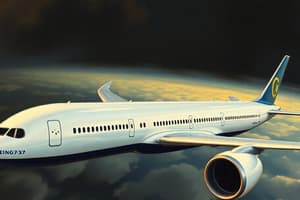Podcast
Questions and Answers
What unique limitations does the B787 have compared to the B767?
What unique limitations does the B787 have compared to the B767?
- Different wind limits for takeoff and landing (correct)
- Shorter minimum runway length requirement
- Increased maximum takeoff weight
- Higher turbulence penetration speed
What is the maximum crosswind limit for the B787?
What is the maximum crosswind limit for the B787?
- 30 knots
- 40 knots
- 65 knots
- 50 knots (correct)
Which electrical system component is affected if the PECS fails?
Which electrical system component is affected if the PECS fails?
- Environmental control systems (correct)
- Flight control systems
- Primary flight displays
- Landing gear systems
What is the wing anti-ice power source on the B787?
What is the wing anti-ice power source on the B787?
What is the limitation for altimeter differences in the B787?
What is the limitation for altimeter differences in the B787?
How many packs are installed in the B787 air conditioning system?
How many packs are installed in the B787 air conditioning system?
What should be considered regarding taxiing on a 45-meter runway?
What should be considered regarding taxiing on a 45-meter runway?
How many outflow valves are there in the B787 pressurization system?
How many outflow valves are there in the B787 pressurization system?
What is a key difference in the FBW systems between Airbus and Boeing aircraft?
What is a key difference in the FBW systems between Airbus and Boeing aircraft?
What function activates the autothrottle in stall protection systems of the B787?
What function activates the autothrottle in stall protection systems of the B787?
What is the primary backup power source for electrical brakes in the B787?
What is the primary backup power source for electrical brakes in the B787?
Which of the following describes the timing of the EICAS 'SPEEDBRAKE' warning?
Which of the following describes the timing of the EICAS 'SPEEDBRAKE' warning?
When does the RTO (rejected takeoff) auto brake function become operational?
When does the RTO (rejected takeoff) auto brake function become operational?
What type of EICAS message indicates a non-time critical alert?
What type of EICAS message indicates a non-time critical alert?
Which of the following systems in the B787 alerts the crew about windshear conditions?
Which of the following systems in the B787 alerts the crew about windshear conditions?
What must be done if the OAT is -7°C and time on the ground exceeds 60 minutes?
What must be done if the OAT is -7°C and time on the ground exceeds 60 minutes?
What effect does a low speed condition have on auto throttle functionality?
What effect does a low speed condition have on auto throttle functionality?
Which situation could prevent auto throttle from activating?
Which situation could prevent auto throttle from activating?
At what altitude can the autopilot be used during a visual approach?
At what altitude can the autopilot be used during a visual approach?
How do the bank angle limiting parameters differ between HDG mode and LNAV?
How do the bank angle limiting parameters differ between HDG mode and LNAV?
What is the primary caution when conducting an ILS DA landing?
What is the primary caution when conducting an ILS DA landing?
What happens when continuing to use IAN below Decision Altitude (DA)?
What happens when continuing to use IAN below Decision Altitude (DA)?
What limitation exists for autopilot usage during landing sequences?
What limitation exists for autopilot usage during landing sequences?
What system improvements have been made regarding auto throttle functionality?
What system improvements have been made regarding auto throttle functionality?
What is the impact of altitude on the auto throttle system (ATS)?
What is the impact of altitude on the auto throttle system (ATS)?
What is a significant threat when using electric engines over pneumatic systems?
What is a significant threat when using electric engines over pneumatic systems?
Which statement accurately describes a change made after the battery accident?
Which statement accurately describes a change made after the battery accident?
What type of generator is typically installed in the electrical system of aircraft like the B787?
What type of generator is typically installed in the electrical system of aircraft like the B787?
What function does the autostart provide during engine initialization?
What function does the autostart provide during engine initialization?
If the main battery fails while in the air, which other system is likely to be affected?
If the main battery fails while in the air, which other system is likely to be affected?
How long can the battery sustain operations without an external power source?
How long can the battery sustain operations without an external power source?
What is the main purpose of the large motor power supply in electrical systems?
What is the main purpose of the large motor power supply in electrical systems?
What are the characteristics of the B787 engine that make it distinct?
What are the characteristics of the B787 engine that make it distinct?
Which of the following is a merit of fly-by-wire systems in aircraft?
Which of the following is a merit of fly-by-wire systems in aircraft?
What scenario would prevent a second start attempt of the B787 engine?
What scenario would prevent a second start attempt of the B787 engine?
What does the flight path vector (FPV) indicate in aircraft instrumentation?
What does the flight path vector (FPV) indicate in aircraft instrumentation?
What must be achieved to view a cross-section in Flight Management Architecture (FMA)?
What must be achieved to view a cross-section in Flight Management Architecture (FMA)?
What is indicated by the 'NAV AIR DATA SYS' message on the EICAS?
What is indicated by the 'NAV AIR DATA SYS' message on the EICAS?
Which speed limitations should be followed if the Flight Management Computer (FMC) is inoperative?
Which speed limitations should be followed if the Flight Management Computer (FMC) is inoperative?
What is the difference between 'unreliable airspeed' and 'NAV airspeed data'?
What is the difference between 'unreliable airspeed' and 'NAV airspeed data'?
What unique feature is characteristic of the hydraulics system in the Boeing 787?
What unique feature is characteristic of the hydraulics system in the Boeing 787?
What fuel is prohibited for use in the aircraft?
What fuel is prohibited for use in the aircraft?
When does the 'FUEL LOW' indicator typically appear?
When does the 'FUEL LOW' indicator typically appear?
During flight, when is the RAT (Ram Air Turbine) automatically deployed?
During flight, when is the RAT (Ram Air Turbine) automatically deployed?
What is a key function of the Mode S transponder?
What is a key function of the Mode S transponder?
Study Notes
Differences between B787 and B767
- B787 utilizes advanced composite materials, enhancing fuel efficiency and reducing weight compared to B767.
- Major aerodynamic improvements in B787 reduce drag, translating to better range and performance.
- Electrical systems differ significantly: B787 has a fully integrated electrical system with more electrical components, while B767 relies more on hydraulic systems.
- B787's Pax O2 system offers improved efficiency and passenger comfort compared to the B767.
Limitations of B787
- Minimum required width for a 180-degree turn is dependent on aircraft dimensions and configuration.
- Caution during taxiing regarding wingtip clearance and other aircraft in proximity is critical.
- The B787 can operate on a 45m runway but requires careful management of weight and balance.
- Turbulence penetration speed should be monitored; significant reduction may be advised during severe turbulence.
Airplane General
- B787 dimensions differ from previous aircraft, with a larger wingspan contributing to aerodynamic efficiency.
- Must carry specific documents onboard according to regulations, including maintenance and flight manuals.
- Emergency equipment count in the cockpit is predefined and must be easily accessible.
Air Systems
- PECS (Pneumatic Electrical Control System) manages pneumatic systems, while ICS (Integrated Control System) oversees various aircraft systems.
- Bleed air systems affected by PECS failure can hinder performance and efficiency.
- Recent air conditioning issues include temperature control failures in specific scenarios.
Anti-Ice and Rain
- Wing anti-ice power source derives from engine bleed air, with protocols for OAT below -7°C.
- After 60 minutes on the ground, specific checks and system configurations must be performed.
Automatic Flight
- Autopilot limitations vary by flight phase, with specific disengagement altitudes below 1500ft.
- Auto land capabilities are available, with careful management required during IAN approach.
- Use of VNAV mode requires understanding of descent and approach profile changes.
Communications
- Multiple PTT (Push-to-Talk) buttons are installed for effective communication, ensuring redundancy.
- Threat assessments for TCP design focus on communication lapses during critical phases.
Electrical Systems
- Transition of hydraulic systems to electrical systems has enhanced reliability but introduces specific threats.
- The design incorporates changes post-battery incidents, enhancing safety protocols.
- Main and APU batteries are crucial for system operations; failure indicators are vital for crew awareness.
Engines and APU
- B787 engines utilize state-of-the-art technologies for efficiency and performance.
- Manual engine starts are possible under specific circumstances; procedures for autostart failures are defined.
Fire Protection
- Fire protection systems differ in configuration for in-flight and ground operations, enhancing safety protocols.
Flight Controls
- Fly-by-wire technology streamlines control inputs and system responses.
- HUD (Head-Up Display) offers critical flight path information and aids in situational awareness.
Flight Management and Navigation
- IRS limitations must be understood for accurate navigation.
- Data sources for various flight instruments must be cross-referenced for ensuring operational integrity.
Fuel Management
- Fuel usage limitations and prohibited types must be adhered to, including cross-feed operations.
- Fuel imbalance procedures are critical for maintaining aircraft stability.
Hydraulics
- The B787's hydraulic system is unique, featuring distinct operational modes for various components.
- RAT (Ram Air Turbine) deployment procedures and functionality are vital in emergencies.
Landing Gear
- The braking system operates automatically under certain conditions, with backup sources defined for emergencies.
Warning Systems
- B787 features multiple protective systems, including stall protections and windshear alerts.
- EICAS messages categorize warnings, with time-critical alerts requiring immediate action.
Maneuvers
- Specific procedures for windshear escape maneuver must be memorized and practiced for emergency situations.
Procedures
- Comprehensive pre-flight checks ensure readiness for departure, with deviation calls specified for approaches.
- Involves specific protocols for engine failure and volcanic ash encounters during flight.
Performance
- Performance characteristics define V1 speeds, with optimum V1 offering benefits but also associated threats.
- Effective management of performance metrics is crucial for successful flight operations.
Studying That Suits You
Use AI to generate personalized quizzes and flashcards to suit your learning preferences.
Related Documents
Description
Test your knowledge on the differences between the Boeing 787 and 767 aircraft. This quiz covers various aspects including electrical systems, limitations, and the passenger oxygen system. Dive in and see how familiar you are with the unique features that distinguish these two models.



